The ancient Romans used geese to guard the Capitol. When the Gauls invaded in the 4th century BC, squawking geese sounded the alarm.
The ancient Romans used geese to guard the Capitol. When the Gauls invaded in the 4th century BC, squawking geese sounded the alarm.
I distinctly remember the first time I saw a painting by Caravaggio, in an art book my aunt had given me for my birthday. It was a very violent picture, which I won’t post here. But I remember being horrified and fascinated and, although I couldn’t have articulated it when I was eight, completely blown away by his realism and his use of light and dark. I’ve been semi-obsessed with him ever since.
Michelangelo Merisi da Caravaggio (1571 – 1610) was a genius of a painter, but not much of a people person.
Caravaggio came from humble origins, the son of a stone-cutter, and apparently had a chip on his shoulder about that for most of his adult life.
He moved from Milan to Rome while in his twenties, looking for painting commissions in the newly built churches and palazzi that were springing up there.
Caravaggio became known as a master of realism—populating his paintings with contemporary, ordinary people—many of them rogues and ruffians from the mean streets of Rome. Here’s one called The Death of the Virgin (ca 1605-6). It caused a huge scandal:

What shocked people at the time was, for starters, the way the Virgin is portrayed. Her dead body is sprawled on a cot in a bare room at an awkward angle, her feet dirty and swollen. But what also shocked people was that the artist chose as his model a well-known Roman prostitute. You have to understand how edgy this was. People were used to looking at devotional paintings showing choirs of angels and golden shafts of light beaming down from Heaven.
A big part of Caravaggio’s problem is that he felt (correctly) that he was underappreciated as a painter. He was hot-headed and quick to pick a fight, and kept getting into trouble. In 1594 he was arrested for hurling a plate of artichokes at a waiter, and he was forever getting involved in Roman street brawls.
 In 1606 he really messed up. While he was playing an early version of tennis, palla a corda, with a close friend, a wealthy acquaintance named Ranuccio Tomassoni walked by with a couple of his relatives and challenged Caravaggio to a game. They played. Each thought he’d won. They drew swords. They chased each other around, hacking away. Caravaggio was slashed twice, but then buried his blade in his enemy’s stomach. Ranuccio died shortly thereafter, and Caravaggio’s friends dragged Caravaggio away to a nearby house to bandage him up.
In 1606 he really messed up. While he was playing an early version of tennis, palla a corda, with a close friend, a wealthy acquaintance named Ranuccio Tomassoni walked by with a couple of his relatives and challenged Caravaggio to a game. They played. Each thought he’d won. They drew swords. They chased each other around, hacking away. Caravaggio was slashed twice, but then buried his blade in his enemy’s stomach. Ranuccio died shortly thereafter, and Caravaggio’s friends dragged Caravaggio away to a nearby house to bandage him up.
The police came after him, and Caravaggio fled for the hills outside of Rome. He became a fugitive from the law. He was convicted of murder in absentia, and sentenced to death.
For the next few years, he continued to paint while on the run. His reputation as an artist was growing. Still pursued by the law, he fled to Malta in 1607, got in trouble there, and fled to Sicily. By 1609, he was widely known as a master painter, and he traveled to Naples to await word from the Pope that his petition to be pardoned might be approved. While there he was ambushed by four assassins, who stabbed him around the face and neck. (Who knows who they were exactly—the guy had made a lot of enemies.) He managed to survive the attack, but was left disfigured.
When his papal pardon finally arrived, in 1610, he set sail for Rome but fell ill on the way with a fever—probably malaria. He died in 1610.
In 1573 the painter Paolo Veronese (1528 – 1588) was called before the Roman Catholic Inquisition to answer some questions about his massive painting of the Last Supper. Measuring 18 x 42 feet, it was painted for the rear wall of a convent in Venice. Here’s a picture of it, which of course can’t really show you much, but you can get an idea:
Veronese realized he was in serious trouble during his questioning, when it became apparent that he was at risk of being convicted of heresy (punishable by death). His inquisitors demanded to know why he had trivialized an event so fundamental to the Christian faith. Instead of the traditional Last Supper, he’d painted a raucous banquet populated by “buffoons, drunken Germans, dwarfs and other such scurrilities,” including a guy with a nosebleed and another guy picking his teeth with a fork. There were dogs, cats, and Huns in this sacred scene. And he’d left out Mary Magdalene altogether.
The tribunal demanded that he repaint the offending parts of the scene within three months. But after the trial was over, Veronese came up with another plan: he renamed the painting The Feast in the House of Levi, which evidently appeased the tribunal because they stopped bothering him about it.
You can read a transcript of the trial here.
And you can watch this amusing Monty Python skit where Michelangelo proposes to an enraged pope that they rename his offensive painting “The Penultimate Supper.”
Auguste Rodin, best known for his sculpture The Thinker, tried to enroll in the prestigious School of Fine Arts in Paris, but failed the exam three times.
According to a recent study, in the highest-grossing 100 films of 2012, 70 percent of the speaking roles belonged to men.
Last weekend I was up at Colby College, in Waterville, Maine, to watch my son play in a basketball tournament. After his game on Saturday, we went to a concert of the Colby Wind Ensemble called “Banned Band Works,” directed by the very charming Eric Thomas.
The first piece in the program was by Hanns Eisler (1898 – 1962) and was entitled “Auferstanden aus Ruinen.” (That means “raised out of the ruins.”) It used to be the National Anthem of East Germany, back when there was an East Germany. Eisler wrote it in 1949, and it was the GDR’s anthem until the fall of the Berlin Wall and the reunification of Germany in 1990. I found the piece so beautiful (and Mr. Thomas’s intro to it so intriguing) that I did some research about Eisler.
Eisler began as a 12-tone composer, studying under Arnold Schoenberg, although he later abandoned the atonal and moved toward a more “popular” style. In the 1930s he collaborated with poet/playwright Bertolt Brecht. (That’s Eisler on the left, above, and Brecht on the right.) In 1933 Eisler’s music was banned by the Nazis. (Eisler was Jewish.) He and Brecht both fled the Nazis, and eventually ended up in Hollywood, where Eisler wrote film scores. His successful film career—one of his scores was nominated for an Academy Award–ended abruptly when he was blacklisted in Hollywood as a socialist, after facing the House Un-American Activities Committee.
According to this essay by David Yearsley, the FBI file on Eisler was 686 pages long. Despite support from Charlie Chaplin, Igor Stravinsky, Aaron Copland, and Virgil Thomson, Eisler faced certain deportation, and returned to Germany in 1948.
So in 1990, when the Germans realized they had one-too-many national anthems, they opted to go with the West German rendition. That’s the one you’ll hear played at the Olympics when someone from Germany wins a gold medal. The melody was written by Haydn. I guess if your anthem has to get preempted by someone else’s anthem, it may as well be Haydn’s. But really, it’s a shame Eisler’s anthem is no longer played. They’re both pretty awesome.
Click here to hear the East German/Eisler anthem on youtube.
And here is the Haydn melody–the anthem of reunified Germany.
Benjamin Franklin objected to the selection of the bald eagle as the national symbol by the Continental Congress. He thought it should have been the turkey.
When a baby was born in ancient Sparta, the family would hang an olive branch on their front door to announce a boy, or a piece of woolen cloth if it was a girl.
For those of you who are doing the shopping and cooking for Thanksgiving this year–or if you’re helping your mom or dad with the preparations (good for you!)–here are a few pictures showing people shopping and preparing food back in the day.
I actually love cooking for Thanksgiving, but I do appreciate my appliances.
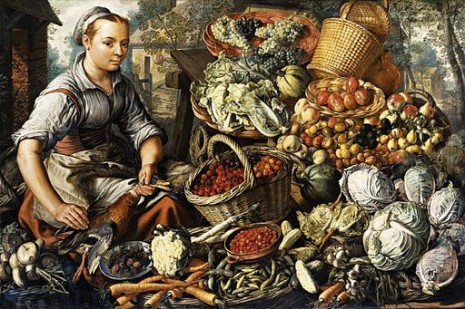
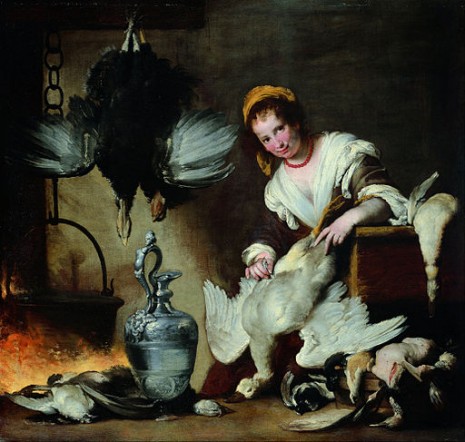
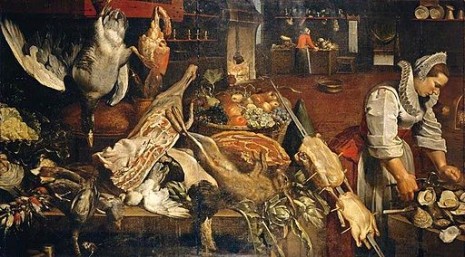
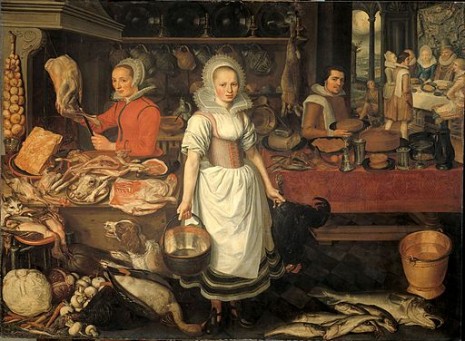
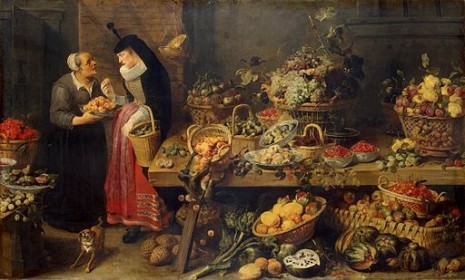
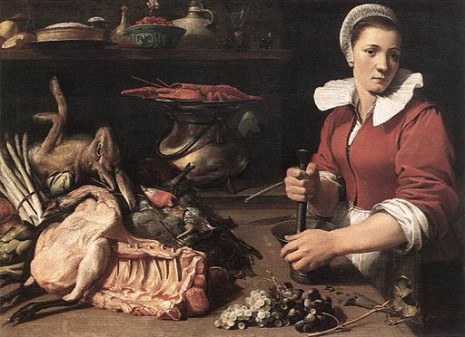 I’m also really thankful that I don’t have to wear a ruff collar while I’m cooking.
I’m also really thankful that I don’t have to wear a ruff collar while I’m cooking.
A sixteenth century surgeon named Leonardo Fioravanti (1517-1588) picked up the chopped off nose of a gentleman after a duel, washed it with his own urine, and sewed it back on.